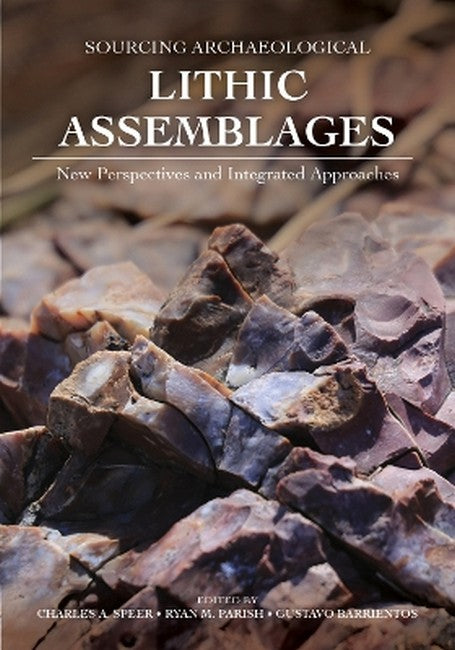Charles A. Speer is associate professor of anthropology at Idaho State University and the curator of anthropology at Idaho Museum of Natural History. Ryan M. Parish is associate professor of archaeology at the University of Memphis. Gustavo Barrientos is a professor of archaeology at the National University of La Plata and principal researcher of the National Scientific and Technical Research Council (CONICET), Argentina. Contributions by AgustIn Agnolin, Pedro Andrade, Hassan Aouraghe, Said Bengamra, Alfonso Benito-Calvo, CEsar Borie, Adam Burke, Adrian Burke, Gisela Cassiodoro, Luciana Catella, M. Gema ChacOn, Gabriela Coelho dos Santos, Josefina Flores Coni, Kane Ditchfield, Trudy Doelman, StEphan Dubernet, Analia Castro Esnal, Silvana Espinosa, Carola Flores, Bretton Giles, Michael Glascock, Rafael GoNi, Bernard Gratuze, Hamid Haddoumi, Jillian Huntley, Rebekah Kurpiel, Juan Ignacio Morales, Khori Newlander, Laura OlguIn, Fernando Oliva, CEsar Parcero-OubiNa, Cecilia. PErez de Micou, Ximena Power, Robert Sala-Ramos, Diego Salazar, Marta SAnchez de la Torre, Morgan Smith, MarIa Soto, Mohamed Souhir, Charles Stern, Andoni TarriNo, Norberto Uriz, Ingrid Ward, John Webb, and FranCois Xavier Le Bourdonnec.
Request Academic Copy
Please copy the ISBN for submitting review copy form
Description
List of Figures List of Tables 1. Introduction: Sourcing Archaeological Lithic Assemblages byCharles A. Speer, Ryan M. Parish, and Gustavo Barrientos Part 1: Variations on a Theme: Sourcing Toolstone through Qualitative and Quantitative Methods 2. The Use of Provenience Data to Formulate or Test Provenance Hypotheses: GIS-Based Models for the Identification of Probable Chert SilIceo Source Areas in East-Central Argentina by Luciana Catella, Gustavo Barrientos, Norberto Uriz, Gabriela Coelho dos Santos, and Fernando Oliva 3. Nodules in a Haystack: Tracing Lithic Raw Material Sources in the Atacama Desert by CEsar I. Borie, CEsar Parcero-OubiNa, Ryan Parish, Diego R. Salazar, Carola F. Flores, Laura A. OlguIn, Pedro M. Andrade, and Ximena M. Power 4. Targeting Coastal Plains Chert in the Wacissa Quarry Cluster, Northwest Florida, USA: A Lidar-Based Geomorphic Model for Locating Terrestrial Chert Quarries by Adam M. Burke and Morgan F. Smith 5. Sourcing Stone and Ochre Artifacts: A Review of Why It Matters in Australia (and Beyond) by Kane Ditchfield, Jillian Huntley, Ingrid Ward, John Webb , Trudy Doelman, and Rebekah Kurpiel 6. The Promise and Challenge of Sourcing Chert Artifacts in the North American Great Basin by Khori Newlander 7. Sourcing Chert Mortuary Bifaces as Indicators for Hopewell Community Participation at the Crib Mound Site, Indiana, USA by Ryan M. Parish and Bretton T. Giles 8. Applying ED-XRF, LA-ICP- MS, and PIXE Analyses to Characterize Pyrenean Cherts: Potentials and Limitations by Marta SAnchez de la Torre, FranCois-Xavier Le Bourdonnec, StEphan Dubernet, and Bernard Gratuze 9. A Pilot Study in Nodular Elemental Variation by Charles A. Speer Part 2: Regional Perspectives and Sourcing under Variable Conditions 10. Raw Material Procurement and Territorial Mobility in the AIn Beni Mathar-GuefaIt Region (Eastern Morocco) by MarIa Soto, M. Gema ChacOn, Hassan Aouraghe, Juan Ignacio Morales, Hamid Haddoumi, Mohamed Souhir, Alfonso Benito-Calvo, Andoni TarriNo, Said Bengamra, and Robert Sala-Ramos 11. Black Obsidian from Pampa del Asador (Santa Cruz, Patagonia, Argentina): A Regional Source by Gisela Cassiodoro, Rafael GoNi, Silvana Espinosa, AgustIn Agnolin, and Josefina Flores Coni 12. Provenance and Transport of Obsidian in Chubut (Central Patagonia, Argentina): From the Early Holocene to Historical Contexts by AnalIa Castro Esnal, Cecilia PErez de Micou, and Charles R. Stern 13. Geology and Geochemistry of the Ledge Ridge Chert Source, Western Maine by Adrian L. Burke 14. Sourcing Archaeological Lithic Assemblages: New Perspectives and Integrated Approaches by Michael D. Glascock References Index
The studies presented in this volume demonstrate creativity and a depth of thought rarely found in many lithic-sourcing studies, and this volume will be a welcome addition to anyone interested in connecting stone artifacts to their sources."-;Matthew T. Boulanger, Southern Methodist University "The editors and authors of this volume are to be commended. It was fascinating to see so many different approaches to the issue of lithic provenance analysis, and to see the many different stages at which these programs of research are established globally."-Rachel ten Bruggencate, University of Manitoba

